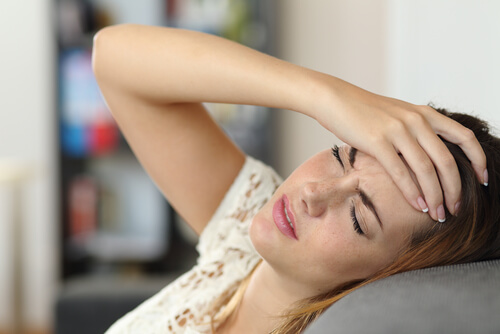Migraines During Adolescence: A Sensitive Problem

In this article, we’ll share with you the most common causes and treatment methods for migraines during adolescence.
Most of the times, headaches are temporary and we don’t pay a lot of attention to them. There are times however, when headaches can become more persistent and unbearable. Therefore, the topic of migraines during adolescence deserves to be treated with care.
Migraines are recurrent and intense headaches. They’re usually related to vascular disorders of the brain.
Migraines feel like headaches but with increased pressure on the nerves, blood vessels, neck and shoulders. According to experts, headaches are the most prevalent neurological disorders during the pediatric age which includes adolescence.
Dr. Charles Wibblesman, a member of the American Academy of Pediatrics, says that many of these headaches are due to the pressures of adolescent life such as stress caused by school, sports, family and friends.

Migraines are more intense and recurrent than regular headaches. They’re also typically unilateral. Migraines are more common in women and they occur most between the ages of 10 and 30.
Some experts believe that this condition can be inherited, since 50% of those who suffer from it have relatives who also suffer or suffered from migraines. The most accepted patho-physiological explanation is neurogenic inflammation due to the activation of the trigeminovascular system.
How to recognize migraines
Migraines are characterized by their sudden onset. They can also be accompanied by the following symptoms:
- Nausea or vomiting.
- Throbbing pain.
- Pain that doesn’t go away with medication and worsens with exercise (such as climbing the stairs).
- Vision problems such as extreme sensitivity to light, loss of vision in a specific area or the perception of scattered lights.
- Lack of appetite.
- Fatigue.
“Migraines are more intense and recurrent than regular headaches.”
Causes of migraines during adolescence
While the exact triggers of migraines are still unknown and under study, there are certain factors that can influence the onset of migraines such as:
- Genetics: it’s not entirely clear how migraines are inherited, however, it has been discovered that certain types of migraines can be transmitted through the 9th chromosome.
- Head injuries: a concussion with or without loss of consciousness.
- Stress: tension, anxiety and anguish can all cause negative reactions to occur, lowering the body’s defenses.
- Hormones: hormones are the main reasons why migraines occur more in females than in males during adolescence. Migraines usually get worse during ovulation and menstruation. Oral contraceptives can also cause migraines in certain cases. It has been noted however that pregnancy and menopause can reduce the occurrence of migraines.
- Bad habits: this is mostly related to food and alcohol intake. Foods that contain mono-sodium, glutamate, tyramine and nitrates can all make migraines worse.
- Lack of sleep: sleep deprivation and overexposure to mobile screens and computers can trigger migraines.
- The environment: strong lights, changes in temperature and altitude can also cause migraines.

The treatment of migraines during adolescence
First of all, it’s important to clarify that this condition is not easily diagnosable. In fact, it can take months to detect migraines. Specialists only consider it to be “probable” after ruling out other pathologies.
Once the diagnosis has been made, one of the most effective ways to alleviate the initial phase of symptoms is with rest and the use of medication. Doctors usually recommend analgesics, anti-inflammatory’s, anti-emetics, ergotamine and triptans.
In addition, pharmacological and non-pharmacological preventative methods can be employed. Medications such as beta-blockers, neuro-modulators, calcium antagonists, antidepressants and anti-hypertensive agents can be used to prevent migraines. Botox is being used as an innovative way to prevent migraines.
“Migraines aren’t easy to detect; in some cases, it can take months to diagnose the condition.”
Non-pharmacological prevention consists of correcting eating habits such as incorporating nutrients that may be lacking such as certain vitamins. There are also physical treatment methods such as massages, acupuncture and yoga.
Other methods can be used to promote relaxation and proper posture. Some doctors recommend psychological treatment through hypnotherapy or psychotherapy.
Last piece of advice
People who suffered from migraines during adolescence recommend keeping track of the date of appearance of symptoms, duration and possible triggers. When it comes to women, it’s important to keep track of the start date of menstruation cycles in order for doctors to have more information and establish possible connections.
In this article, we’ll share with you the most common causes and treatment methods for migraines during adolescence.
Most of the times, headaches are temporary and we don’t pay a lot of attention to them. There are times however, when headaches can become more persistent and unbearable. Therefore, the topic of migraines during adolescence deserves to be treated with care.
Migraines are recurrent and intense headaches. They’re usually related to vascular disorders of the brain.
Migraines feel like headaches but with increased pressure on the nerves, blood vessels, neck and shoulders. According to experts, headaches are the most prevalent neurological disorders during the pediatric age which includes adolescence.
Dr. Charles Wibblesman, a member of the American Academy of Pediatrics, says that many of these headaches are due to the pressures of adolescent life such as stress caused by school, sports, family and friends.

Migraines are more intense and recurrent than regular headaches. They’re also typically unilateral. Migraines are more common in women and they occur most between the ages of 10 and 30.
Some experts believe that this condition can be inherited, since 50% of those who suffer from it have relatives who also suffer or suffered from migraines. The most accepted patho-physiological explanation is neurogenic inflammation due to the activation of the trigeminovascular system.
How to recognize migraines
Migraines are characterized by their sudden onset. They can also be accompanied by the following symptoms:
- Nausea or vomiting.
- Throbbing pain.
- Pain that doesn’t go away with medication and worsens with exercise (such as climbing the stairs).
- Vision problems such as extreme sensitivity to light, loss of vision in a specific area or the perception of scattered lights.
- Lack of appetite.
- Fatigue.
“Migraines are more intense and recurrent than regular headaches.”
Causes of migraines during adolescence
While the exact triggers of migraines are still unknown and under study, there are certain factors that can influence the onset of migraines such as:
- Genetics: it’s not entirely clear how migraines are inherited, however, it has been discovered that certain types of migraines can be transmitted through the 9th chromosome.
- Head injuries: a concussion with or without loss of consciousness.
- Stress: tension, anxiety and anguish can all cause negative reactions to occur, lowering the body’s defenses.
- Hormones: hormones are the main reasons why migraines occur more in females than in males during adolescence. Migraines usually get worse during ovulation and menstruation. Oral contraceptives can also cause migraines in certain cases. It has been noted however that pregnancy and menopause can reduce the occurrence of migraines.
- Bad habits: this is mostly related to food and alcohol intake. Foods that contain mono-sodium, glutamate, tyramine and nitrates can all make migraines worse.
- Lack of sleep: sleep deprivation and overexposure to mobile screens and computers can trigger migraines.
- The environment: strong lights, changes in temperature and altitude can also cause migraines.

The treatment of migraines during adolescence
First of all, it’s important to clarify that this condition is not easily diagnosable. In fact, it can take months to detect migraines. Specialists only consider it to be “probable” after ruling out other pathologies.
Once the diagnosis has been made, one of the most effective ways to alleviate the initial phase of symptoms is with rest and the use of medication. Doctors usually recommend analgesics, anti-inflammatory’s, anti-emetics, ergotamine and triptans.
In addition, pharmacological and non-pharmacological preventative methods can be employed. Medications such as beta-blockers, neuro-modulators, calcium antagonists, antidepressants and anti-hypertensive agents can be used to prevent migraines. Botox is being used as an innovative way to prevent migraines.
“Migraines aren’t easy to detect; in some cases, it can take months to diagnose the condition.”
Non-pharmacological prevention consists of correcting eating habits such as incorporating nutrients that may be lacking such as certain vitamins. There are also physical treatment methods such as massages, acupuncture and yoga.
Other methods can be used to promote relaxation and proper posture. Some doctors recommend psychological treatment through hypnotherapy or psychotherapy.
Last piece of advice
People who suffered from migraines during adolescence recommend keeping track of the date of appearance of symptoms, duration and possible triggers. When it comes to women, it’s important to keep track of the start date of menstruation cycles in order for doctors to have more information and establish possible connections.
All cited sources were thoroughly reviewed by our team to ensure their quality, reliability, currency, and validity. The bibliography of this article was considered reliable and of academic or scientific accuracy.
- Arroyo, H. A. (2007). Migraña y otras cefaleas primarias en la infancia y la adolescencia. Medicina (B Aires), 67, 623-30. http://medicinabuenosaires.com/revistas/vol67-07/n6-1/v67_6-1_p623_630_.pdf
- Bille B. (1991). Migraine in childhood and its prognosis. Cephalalgia. 1: 71-5.
- Cárdenas Guiraudy, A., García Martínez, D. A., Pozo Lauzan, D., Pozo Alonso, A., & Moroño Guerrero, M. (2005). Migraña: Estudio clínico-genético en niños y adolescentes. Revista Cubana de Pediatría, 77(1), 0-0. http://scielo.sld.cu/scielo.php?pid=S0034-75312005000100001&script=sci_arttext&tlng=en
- Headache Classification Committee of the International Headache Society. (1988). Classification and diagnostic criteria for headache disorders, cranial neuralgias and facial pain. Cephalalgia. 8. (suppl 7: 1-96).
- Ozge A, Saşmaz T, Buğdaycı R, Cakmak SE, Kurt AÖ, Kaleağası SH, Siva A. The prevalence of chronic and episodic migraine in children and adolescents. Eur J Neurol. 2013 Jan;20(1):95-101.
- Sahd-Brown KE, Ruth-Sahd LA. Migraña Aguda en niños. Nursing (Ed española). 2018;35(6):26–31.
- Pedraza Hueso MI, Ruíz Piñero M, Martínez Velasco E, Juanatey García A, Guerrero Peral AL. Cefalea en jóvenes: Características Clínicas en Una Serie DE 651 casos. Neurología. 2019;34(1):22–6.
This text is provided for informational purposes only and does not replace consultation with a professional. If in doubt, consult your specialist.








